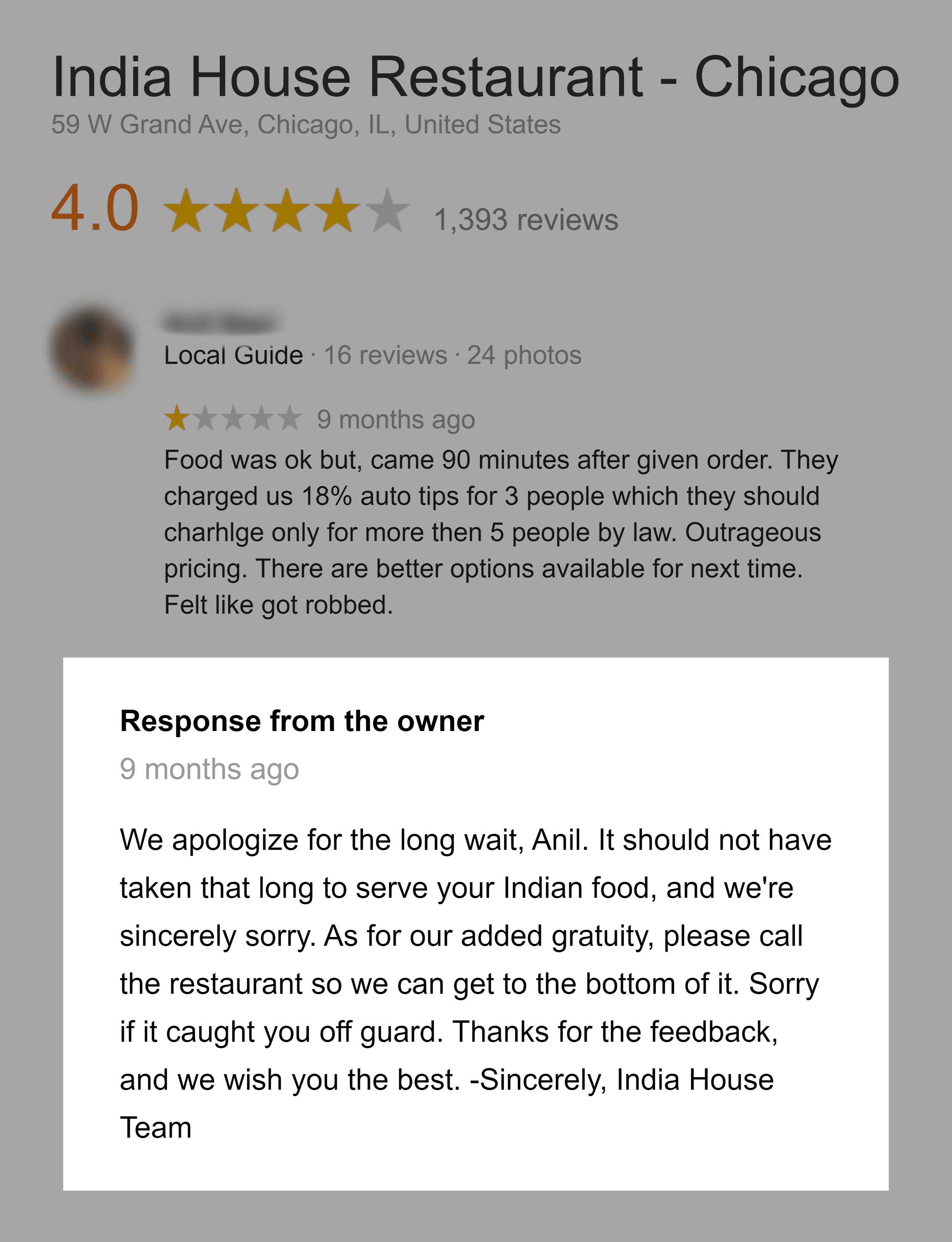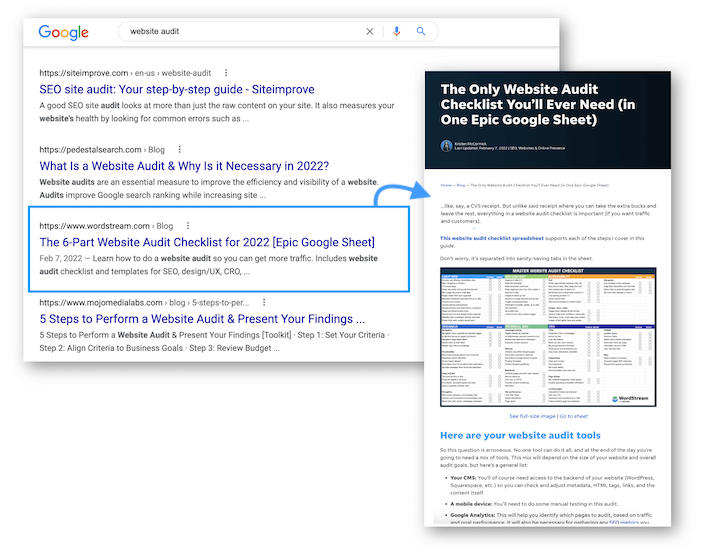In 2022, having an online presence for your restaurant business is essential.
When looking for new places to eat, people turn to search for thousands of results at their fingertips – and the competition is fierce.
If you want locals to find your restaurant when looking for places to eat in the area, you need to work on your online presence and feature prominently in those search results.
Search engine optimization (SEO) is one of the best and most affordable ways to differentiate your restaurant online.
While the purpose of on-page SEO is to optimize your website, off-page SEO focuses on spreading your reach online.
Below, you’ll find an off-page SEO checklist for restaurants that contains all the elements you need to keep track of regularly.
You will learn about Google My Business, TripAdvisor, Yelp, social media, link building, and more.
1. Claim Your Google Business Profile

Google Business Profile (GBP), formerly known as Google My Business, is one of the most powerful tools for businesses everywhere.
It allows owners to increase the visibility of their business on Google and make a good first impression by highlighting what makes them unique.
Whatever information you decide to highlight is what customers will see when you search your restaurant or restaurants near them on Google.
If you want your customers to find your restaurant on Google Search and Google Maps, you need to claim and fill in your Google Business Profile.
The more information you add about your restaurant, the greater the chance of hungry customers finding it.
Your restaurant website is the most essential element you need to add to Google My Business.
It will bring you an incredibly valuable free backlink and make it easy for people to navigate to your site.
Just as important for a business is displaying your menu and order page.
Google My Business essential additional information includes:
To make your GMB profile more appealing, showcase your daily special programs, promotions, events, and behind-the-scenes videos.
If you have more than one restaurant location, it is good practice to have a separate Google My Business profile for each one.
2. Claim Your Profiles On Yelp And TripAdvisor

Yelp and TripAdvisor are both close second on the restaurant SEO checklist off this page.
According to a BrightLocal survey, 98% of customers read online reviews of businesses in 2021.
Millions of users visit websites like TripAdvisor and Yelp every month.
Naturally, that’s where your restaurant needs to be.
Add your restaurant to TripAdvisor and Yelp, or claim your listing if it’s already there.
Yelp For Restaurants
Once you’ve filled in your basic information, follow these steps to adjust your Yelp profile and stand out in the crowd:
TripAdvisor For Restaurants
The above rules apply to TripAdvisor as well.
Start by filling in profile essentials like name, address and website.
Next, take your profile to the next level with these tips on how to rank higher on TripAdvisor:
3. Link Your Website On Social Media

Social media is another essential aspect of off-page SEO for restaurants. Although not a direct ranking factor, it can still indirectly influence SEO.
How? Redirecting your social media profiles to your site will bring you additional traffic and business, and build your online authority.
However, having the profiles is not enough.
You must have an active presence and interact with your followers to encourage them to share your content.
Every social network has its function.
On Facebook, you can post your menu using the ‘Start Order’ button to boost sales.
Instagram is where your dishes will shine. Post photos that your followers will not be able to resist.
Twitter is an excellent place to address customer concerns.
Use it to update followers on changes of opening hours, new menu items, events, and anything else they might want to know.
While Facebook, Instagram, and Twitter are the holy trinity of social media platforms, there are other platforms you can leverage that can have amazing results, like Pinterest, Snapchat, or TikTok.
On Pinterest, you can post delicious photos of your menu, link to your website, create recipe boards, interact with other people in the restaurant industry, and create unique gifts.
Snapchat can help you attract more local customers using geofilters and engage your audience with a few hidden discount games and codes in your stories.
Use TikTok to connect with a younger audience, create hashtag challenges, make fun schizos and challenges, and take customers behind the scenes.
Don’t forget to add all your social media profiles to your site.
Also use social media to share user-generated content.
However, make sure you have the explicit permission of your customers to share their posts on your pages.
4. Do Link Building Outreach

Getting quality backlinks from high authority websites can help improve your website’s authority, reputation, and search rankings.
Including your restaurant in local online publications will also reveal your business to new customers.
First, search for websites that have a high rating in the food industry and link to them with a guest post presentation.
You can offer your information as a chef or restaurant owner and include a link to your restaurant website in the article.
Next, find local business directories and link to add your restaurant.
The same goes for websites that list the best restaurants in an area.
Offer to include a discount code for their visitors to sweeten the deal.
Create A Restaurant Blog
If you want relevant websites to link to you naturally, consider opening a blog where you share your experience in the restaurant industry.
Remember to do keyword research to find topics that people are interested in reading about so that your articles can rank highly.
Here are some restaurant blog topic ideas that you can explore:
When searching for keywords, remember your restaurant cuisine and the key selling point.
If you own a vegetarian restaurant, for example, you will not write about “how to cut steaks” but rather “vegetarian lunchbox ideas” or “how to season vegetables for grilling.”
5. Collaborate With Food Influencers

Food bloggers and influencers who follow social media can be excellent promoters of your restaurant.
They can help boost your site’s traffic and increase your search engine rankings by linking to your domain.
Invite local influencers to sample your latest menu items just so they can post about them on their blogs and social media.
You can also provide a special discount coupon to his followers.
You can find local influencers on subreddits created by and for food bloggers or use tools like meetup.com to search for food groups meeting in your town.
Try paid blogger outreach software if you’re willing to invest more in blogger outreach.
6. Keep Your NAP Updated Throughout All Platforms
NAP consistency (name, address, phone number) is an important step in restaurant SEO and a vital item on the SEO checklist off this page.
Your NAP information should be available on your site, social media, and third-party websites.
Search engines are particularly fond of this information, as it helps users find the answers to their questions.
In order for your restaurant information to be displayed in relevant searches, you must display and update your NAP information consistently across all platforms.
Make sure the information is spelled the same and displayed in the same format.
Otherwise, it could confuse users and make you unreliable for search engines.
7. Add Your Restaurant On Popular Review Platforms And Business Directories
Once you’ve covered your bases with Google My Business, Yelp, and TripAdvisor, it’s time to research additional directories and websites where you can list your restaurant.
Some of these will help you get a valuable backlink, but all will expose you to new customers.
For example, Bing may not be as popular as Google, but it’s worth adding your restaurant to Bing Places.
Here are other websites where you should add your restaurant to promote off-page SEO:
Remember the advice from the previous section – keep your NAP information consistent across all platforms.
Summary
Good food is just one element of your restaurant’s success.
Without a solid online presence, you can’t cater to today’s food-loving audience.
Getting noticed online starts with your site but continues with off-page restaurant SEO.
From social media to food web site reviews and blogs, check all the SEO checklist items off this page to make your restaurant a match in the local community – and a dominant force in search results.
Featured Image: Monster Ztudio / Shutterstock
How do I do a SEO checklist?
SEO checklist: How to improve your results
- Have a clean site structure. …
- Significant content feature. …
- Use relevant title tags. …
- Add alt tags. …
- Optimization for mobile phone. …
- Enable fast load times. …
- Install Google Search Console and Analytics. …
- Make sure your website and URL are secure.
When should you update your SEO plan?
That said, it is best to update your SEO plan – or at least assess the SEO landscape to establish if a re-strategy is needed – every 1-3 months. This does not mean that you should not have an overall strategic goal of acquiring [x] the volume of traffic or [x] of keywords number 1 over a longer period.
When should you consider updating your SEO plan? That said, it is best to update your SEO plan – or at least assess the SEO landscape to establish whether a re-strategy is needed – every 1-3 months.
How long does it take SEO to update?
While it is perfectly accurate to say that there is no specific answer to how long it takes before you start to see organic improvements from your SEO efforts, most subject matter experts agree that it takes four to usually six months: â € œIn general, websites can see results in 4 to 6 months. â € “SEO Mechanic.
How long does Google SEO take to update?
Website popularity, crawling, and structure are all a factor in how long it will take for Google to index a website. Generally, Googlebot will find its way to a new website between four days and four weeks. However, this is a projection and some users have claimed to have indexed them in less than a day.
How long does it take for SEO to work?
Unlike other popular marketing channels, SEO does not work immediately. Most professionals expect to see results in as little as 2 months, but SEO can take as long as 12 months to work. Although each company’s SEO strategy is different, most businesses can expect to see significant results in 6 to 12 months.
Does updating content improve SEO?
To increase the effectiveness of your SEO efforts and boost your search engine traffic, you can update your old content and give yourself a better freshness rating. When you tell Google that your content is new, you get a huge increase in traffic that will make the minimal amount of work needed worthwhile.
How often should you update content for SEO?
Once, twice, three times blog post You should aim to post at least once a week – and at the same time every week. Weekly posts will give you content to share on your social media channels, as well as boost your SEO rankings by using target keywords.
Does changing content affect SEO?
Yes, making frequent content changes can hurt your SEO if you don’t make them strategically and with a plan.
Does more content increase SEO?
Adding more content to your site can improve your SEO but only if you do it thoughtfully. Don’t make the mistake of adding tons of low quality content unless you want a negative result.
Why updating content is important for SEO?
Old pages have had much more time to build backlinks. By adding internal links to new pages during reviews, you can ensure that your newer content gets its fair share of the rating authority your older content has earned.
Does SEO need to be ongoing?
SEO is an ongoing process that should never end – even once you have the highest ranks for your targeted key terms. Search rankings continually change over time, and the scaling of algorithms is constantly undergoing a major overhaul. On average, Google changes its rating list and search algorithm at least 500 times a year.
What happens when you stop doing SEO?
If you stop doing SEO, you will eventually start seeing lower rankings in search results. Over time, this will lead to less organic traffic to your site and less online visibility. Your rankings will continue to decline until you use SEO strategies to increase them again.
How often does SEO need to be done?
According to Jonny Ross Consultancy and other industry experts, it is recommended that you review your keyword strategy quarterly and at least 3 – 6 months before any campaign or promotions.
What does ongoing SEO mean?
Continuous SEO analyzes the results of services initially provided to make sure they work. Many companies use tools like Google Analytics, MySEOTool, Moz tools, and more to review their activities and then use them to provide continuous SEO improvement.
Is SEO a one-time event?
Search engine optimization (SEO) is a continuous process and not a one-time event. It’s a process because the market, the competition, and the rules-setting companies (search engines) are constantly changing and evolving.
How often does SEO need to be done? According to Jonny Ross Consultancy and other industry experts, it is recommended that you review your keyword strategy quarterly and at least 3 – 6 months before any campaign or promotions.
Is SEO a monthly thing?
One-time SEO is when a site is built or a client wants their site optimized but there is no contract for ongoing monthly service when the initial site or optimization is done (that is not says they will never come back later monthly service, just does not happen immediately after).
Does SEO need to be done monthly?
The truth is, you don’t have to pay an agency for a monthly SEO campaign. And as an agency director, I’m sure many of you were shocked to hear this. SEO is not rocket science.
How often do you need to do SEO?
Revisit Frequency According to Jonny Ross Consultancy and other industry experts, it is recommended that you revisit your keyword strategy quarterly and at least 3 – 6 months before any campaign or promotions.
Is SEO a one-time thing?
Search engine optimization or SEO is an ongoing process. It’s not a one-time event. It’s a process because the market, the competition, and the rules-setting companies – search engines – are constantly changing and evolving.
How much does SEO cost monthly?
This survey also found that the median cost per month for SEO is between $ 2,500 and $ 5,000 per month for SEO services. Thirty-one percent paid above this range, up to $ 50,000, and only 18% paid less than $ 1,000.
How long will SEO last?
You Should Expect To See Results From SEO Within 6 To 12 Months … SEO Should Show Results Within 6 To 12 Months. By results, we mean a measurable increase in traffic and associated wiring or conversions.
Is SEO dead in 2022?
No. SEO is not dead in 2022. SEO is still a very powerful digital marketing strategy. SEO will continue to change as Google updates its algorithm but that is to be expected.
Does SEO last forever?
SEO is many things, but predictable and “forever” it is not. We don’t rely solely on SEO and we don’t think other businesses should; as always a healthy mix of marketing activity is the best way to ensure your lead funnel doesn’t fall overnight.
Will SEO exist in 5 years?
SEO will not be eliminated within the next five years because social media and search engines will probably merge. Facebook has already begun to do this: they average over 1.5 billion searches each day. Twitter has done the same thing; they teamed up in partnership with Google.
Is SEO dead in 2021?
Don’t be fooled: SEO doesn’t die, but it is evolving into much more than it was years ago. If you’ve been debating whether or not you want to invest in SEO for your business, read on to learn why SEO isn’t dying – but actually thriving – in 2021.
Is SEO an ongoing process?
SEO is an ongoing process due to the fact that so many factors play a role in its success. SEO is no longer just keywords and links, rather, websites that cater to users are rewarded. Consumer needs are constantly changing, and your SEO efforts should evolve right along with your audience.
Does SEO need to be ongoing?
SEO is an ongoing process that should never end – even once you have the highest ranks for your targeted key terms. Search rankings continually change over time, and the scaling of algorithms is constantly undergoing a major overhaul. On average, Google changes its rating list and search algorithm at least 500 times a year.
Is SEO a one-time project?
In short, Jumpstart SEO is a one-time optimization that gives you a starting point to find search engines, and ultimately potential clients, customers, or audiences.
What does ongoing SEO mean?
Continuous SEO analyzes the results of services initially provided to make sure they work. Many companies use tools like Google Analytics, MySEOTool, Moz tools, and more to review their activities and then use them to provide continuous SEO improvement.
What is black hat technique?
Black hat SEO is a practice against search engine guidelines, which are used to get a higher ranking position in search results. These unethical tactics do not solve for the searcher and often end with a penalty by search engines. Black hat techniques include keyword stuffing, clogging, and using private link networks.
What is black hat SEO and why should it be avoided? Black hat SEO is a set of practices that contravene search engine guidelines and are used to promote website search rankings. Black hat SEO techniques ignore searcher intent and try to avoid best practices by cheating the system and gaining search visibility through unscrupulous practices.
What is the difference between white hat and black hat technique?
While white hat SEO means looking for ways to improve the user experience, black hat SEO relies on manipulating Google’s algorithm to improve rankings. Simply put, if a tactic is designed to make Google think that a website gives consumers more value than it really is, it’s fraudulent – and it’s black hat SEO.
What is Blackhat and white hat SEO?
White hat SEO techniques are heroes – tactics that work within the terms of service of search engines to improve search engine results page (SERP) rankings. Black hat SEO techniques are vicious – tactics that might get a higher SERP ranking, but are unethical and contrary to search engine guidelines.
What are white hat techniques?
White Hat’s SEO technique, by contrast, refers to using strategies that target a human audience rather than trying to hack a search engine algorithm. Any good SEO campaign will focus more on White Hat SEO, quality content, and link building as the core of their approach.
What is the difference between white hat black hat and gray hat SEO technique?
| THIS Black Hat | SEO White Hat |
|---|---|
| Also known as Unethical SEO. | Also known as Ethical SEO. |
Which technique is example of black hat SEO?
Common examples of black hat SEO strategies include using invisible text, door pages, keyword stuffing, page swapping, or adding unrelated keywords to a page. Each of these techniques is defined below, with insight into how they can be detrimental to any business website.
How many black hat SEO techniques are there?
8 Dangerous Black Hat SEO Techniques.
Which technique is an example of black hat SEO Linkedin?
Common examples of black hat SEO strategies include using invisible text, door pages, keyword stuffing, page swapping, or adding unrelated keywords to a page.
Which technique is an example of black hat SEO Mcq?
Black Hat SEO includes SEO methods that are illegal / bad / unacceptable by search engines referred to as Black Hat SEO. Techniques like Hidden Text, Doorway pages, Link Farming, keyword clogging and stuffing are not acceptable to search engines.
What is white hat technique?
White hat SEO is the body of approved search engine optimization tactics designed to increase website rank on search engine results page (SERP). Search engine results that appear as a result of approved methods, rather than payment or fraud, are referred to as organic search results.

